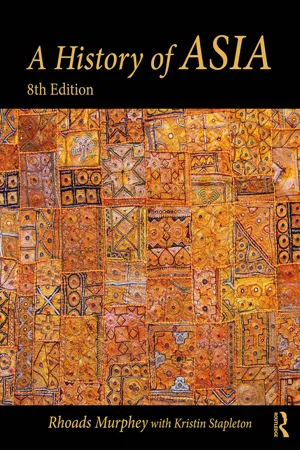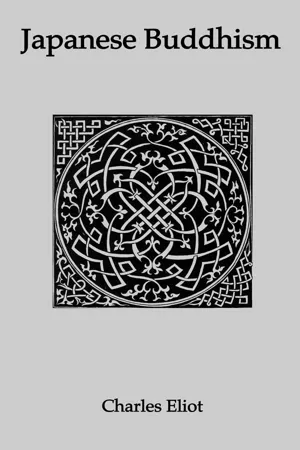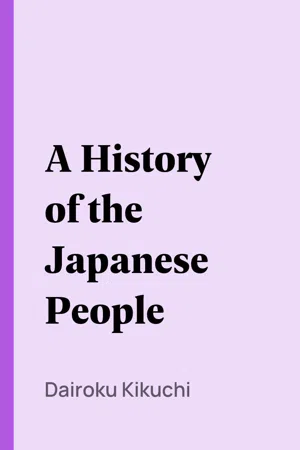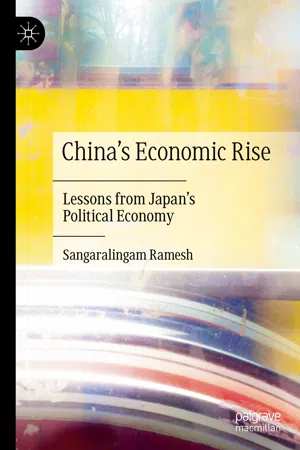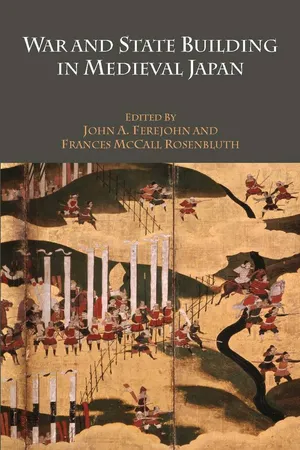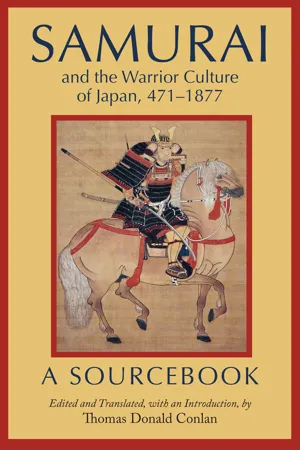History
Ashikaga Shogunate
The Ashikaga Shogunate was a feudal military government in Japan established by the Ashikaga clan in the late 12th century. It marked a period of decentralized rule and cultural flourishing, known as the Muromachi period, characterized by the influence of Zen Buddhism and the development of the tea ceremony and Noh theater. The shogunate faced internal strife and external threats, ultimately leading to its decline in the 16th century.
Written by Perlego with AI-assistance
Related key terms
10 Key excerpts on "Ashikaga Shogunate"
- eBook - ePub
- Jeremy Black, Jeremy Black(Authors)
- 2005(Publication Date)
- Routledge(Publisher)
Chapter ThreeWarfare in Japan 1467–1600Paul VarleyJapan in the mid-fifteenth century was a country on the verge of disintegration. Its emperor, whose court was located in Kyoto, had not exercised real authority for centuries, but was a “sacred legitimizer” of the rule of others. From the late twelfth century, when the first warrior—samurai—government was established at Kamakura in the Kant or eastern provinces (a government known in English as “shogunate”, because its head was the shogun or “generalissimo”), the effective rulers of the land were warrior chiefs. The Kamakura Shogunate spanned the years 1185–1333, and was replaced, after a brief hiatus, by the Ashikaga Shogunate, 1336–1573, which was situated in Kyoto in proximity to the emperor and his court and headed by shoguns of the Ashikaga family.The Ashikaga Shogunate came into existence in 1336 at the commencement of a sanguinary conflict, known as the War Between the Courts, that was not settled until 1392. Even after this war the Shogunate was able to exercise only limited control of the country. Its leader, the shogun, presided as hegemon over semi-independent warrior chiefs invested by him as constables (shugo) of the various provinces (66 in all) into which Japan was divided. But distant areas of the country, especially the island of Kyushu in the west and the northern reaches of the main island of Honshu, were largely beyond effective Shogunate administration, and in the early fifteenth century the vital Kant region, heartland of the warrior class, also slipped from Shogunate control and lapsed into disunion. During the nin War, 1467–77, the Ashikaga Shogunate was reduced to nearimpotence, and Japan itself was plunged into the age of Sengoku or “The Country at War”, 1467–1568.1 - eBook - ePub
- Rhoads Murphey, Kristin Stapleton(Authors)
- 2019(Publication Date)
- Routledge(Publisher)
Under strict Tokugawa control, Japan enjoyed over two centuries of order, prosperity, and economic growth. But control rested on a revived system of feudal ties, and as the economy matured, the population grew, and a new merchant class became more prominent, pressures for change increased. Foreign demands for trade concessions finally broke down Japan’s self-imposed isolation in 1853; this revealed Japan’s weakness and at the same time fed domestic discontent with the Tokugawa rulers. The shogunate was ended in 1868 by what is called the Meiji Restoration; although it did ostensibly restore the emperor, it is more accurately seen as a relatively bloodless revolution that brought to power a new group of radical reformers who set Japan on a course of rapid modernization.THE TOKUGAWA UNIFICATIONUnder the Ashikaga Shogunate, regional feudal lords and their armies competed with each other for dominance as summarized in Chapter 9 . Ashikaga rule from Kyoto became increasingly ineffective in the sixteenth century Although the shogunate was never in control of more than central Japan, areas beyond the immediate vicinity of Kyoto became more and more independent under their own daimyō (feudal lords), each with an army of samurai and based in impressive fortified castles. Fighting between them became chronic, and with the final collapse of the Ashikaga in 1573, Japan dissolved into civil war.Japan was still a small, poor country on the edge of the major Asian stage, divided between warring clans. The settled area was the size of a Chinese province, and the total population numbered only about 15 million. The court and urban culture of Kyoto with their extreme refinement were luxurious, and technologically Ashikaga Japan had made - eBook - ePub
- Charles Eliot(Author)
- 2014(Publication Date)
- Routledge(Publisher)
2After Yoshimitsu the Ashikagas quickly deteriorated, though they did not collapse for some time. The Shōguns became feeble and dissolute, often minora and mere puppets in the hands of their Chief Minister or Kwanryō, a post for which the powerful families of Hosokawa and Ōuchi fought and struggled. The confusion was incredible. At one time there were five rival Shōguns living, most of them minors and tools in the hands of contending factions. Of the last six Shōguns five died in exile and one committed suicide. Anarchy prevailed, the only effective power being in the hands of the great Barons who were constantly at war with one another. Social conditions became changed. The old feudalism had been based on the service owed to a chief by those who held land from him: now chiefs began to take into their service landless men and to maintain private armies of mercenaries, debtors, and adventurers. The oppressed and degraded populace constantly broke out into riots. Owing to internal dissensions and land troubles the ancient noble houses had lost their pre-eminence, and upstart families led by some capable chief became lords of large territories.This explains one feature of the eventful interval between the Ashikaga and the Tokugawa periods, namely, the almost simultaneous rise of three great men, Nobunaga (1534–1582), Hideyoshi (1536–1598), and leyasu (1542–1616), who, starting with little except their talents, became one after another masters of their country. The other feature is the arrival of the Portuguese and of Christianity. This event would have been momentous at any time, but both its immediate effect and the subsequent reaction were unusually violent because hereditary authority and tradition were at their weakest and the de facto - eBook - ePub
Japan
A Short History
- Mikiso Hane(Author)
- 2013(Publication Date)
- Oneworld Publications(Publisher)
Godaigo failed to extend his authority over the land. Samurai discontent turned against the imperial government because they were not properly rewarded. Land and power disputes continued in the provinces. Seeing the unstable state of the imperial court Ashikaga Takauji, who had helped to overthrow the Hōjō government, decided to take power himself. In the ensuing power struggle Takauji succeeded in winning the support of the discontented elements and gained control of Kyoto. He then placed a member of the collateral line of the imperial family on the throne. When he saw pro-imperial forces rising against Takauji, Godaigo decided to join them and fled south to the Kii peninsula. He established a rival government in Yoshino in 1336. Thus there were two imperial courts, the northern court and the southern court. This system of dual imperial dynasties lasted until 1392.Ashikaga Shogunate (1338–1573)
In 1338 Takauji was appointed shōgun by the northern court, and he and his successors sought to subdue the opposition forces and consolidate Ashikaga rule. The third Ashikaga shogun, Yoshimitsu (1358–1408) succeeded in persuading the southern court to return to Kyoto and merge with the northern court in 1392. The descendants of the two courts were to occupy the throne alternately. But this agreement was not kept and the northern court descendants have occupied the throne to the present.Although Yoshimitsu had united the two courts and had established fairly firm control over the country the local chieftains, constables, and land stewards remained entrenched in the provinces. The Ashikaga shōen holdings were not as large as the Hōjō holdings so the Ashikaga government had to rely on taxes to meet its financial needs.After Yoshimitsu’s death in 1408 the shogunate began to experience increasing difficulty in keeping the major constabulary houses under control. These elements had extended their control in the outlying provinces during the years when the country was split between the northern and southern courts. By the middle of the fifteenth century a large number of constables had gained hereditary possession of their posts and began to extend their control over other provinces. They began to take possession of the shōen in their provinces which were formerly held by the imperial court, court nobles, monasteries, and local owners. They had gained taxation rights as well as the power to impose corvée on the people in the shōen. To strengthen their power position they began to convert local officials and independent landholders into their vassals. By the middle of the fifteenth century the shōen holders had virtually lost control of their manors and the constables were emerging as provincial landholding magnates, the daimyō - eBook - ePub
A History of the Japanese People
From the Earliest Times to the End of the Meiji Era
- Dairoku Kikuchi(Author)
- 2008(Publication Date)
- Perlego(Publisher)
"This was an important step in the development of the feudal system. Another was the abolition of feudal fiefs, as well as of the succession of women to real estate, and a curtailment of the inheritance, not so much of younger sons, as of all sons except the one selected as lord of the clan."* The shugo (high constables) also became a salient element of feudalism. Originally liable to frequent transfers of locality, some of them subsequently came to hold their office hereditarily, and these, together with the great majority of their confreres who had been appointed by the Bakufu, espoused the Ashikaga cause; a choice which impelled many of the military families in their jurisdiction to declare for the Southern Court. The Ashikaga shugo ultimately became leading magnates, for they wielded twofold authority, namely, that derived from their power as owners of broad estates, and that derived from their commission as shogun's delegates entitled to levy taxes locally. The provincial governors, at the outset purely civil officials, occasionally developed military capacity and rivalled the hereditary shugo in armed influence, but such instances were rare.*Murdoch's History of Japan.THE COURSE OF THE WAR
After the death of Kusunoki Masashige, of Nitta Yoshisada, and of Kitabatake Akiiye, the strategical direction of the war devolved mainly upon Kitabatake Chikafusa, so far as the Southern Court was concerned. The greater part of the nation may be said to have been in arms, but only a small section took actual part in the main campaign, the troops in the distant provinces being occupied with local struggles. Chikafusa's general plan was to menace Kyoto and Kamakura simultaneously. Just as the eight provinces of the Kwanto formed the base of the Ashikaga armies, so the eight provinces constituting the Kii peninsula—Yamato, Kawachi, Izumi, Ise, Iga, Shima, Kii (in part), and Omi (in part)—served as bases for the partisans of the South. To strike at Kyoto from this base required the previous subjugation of Settsu, and, on the other hand, a strong army in Settsu menaced Yoshino. - eBook - ePub
Japanese Family and Society
Words from Tongo Takebe, A Meiji Era Sociologist
- Phil Barker, Teruhito Sako, Suzanne K Steinmetz(Authors)
- 2007(Publication Date)
- Routledge(Publisher)
This action resulted in the loss of the support of the daimyōs who had been instrumental in the emperor regaining the throne. Unable to retain control without the support of the daimyō, Go-Daigo fled to Yoshino in the south of Kyoto and established the Southern court (Japan-Guide, 2005). The two imperial courts, the Northern (Kyoto) and Southern court (Yoshino) existed for over fifty years until 1392 when the Northern Ashikaga court became the dominant single court. The Ashikaga clan held power for 200 years, but during the fifteenth and sixteenth centuries, the Ashikaga Shogunate and the government at Kyoto declined considerably. At the same time, the daimyō, who were not loyal to the central authority but to the local warrior followers, gained in power. Their power was further increased during the ten-year Ōnin War (1467–1477) followed by a century of warfare (Sengoku Jidai). 10 The Ashikaga Shogunate (and vassals they controlled), the daimyō (and lower-level samurai warriors and peasants loyal to them), and court-appointed civil governors competed for financial and political power. The influence of the Ashikaga bakufu [shogunate] in Kyoto drastically declined and the shōen system was severely damaged. The centralized Confucian-based government was replaced by the daimyō who expanded their landholdings, which varied in size from small castle towns to areas the size of former provinces. They assembled feudal armies consisting of peasants and levied taxes directly on the peasantry. However, they were able to maintain the loyalty and support of the peasants, because they also instituted improvements by promoting local economic development, building roads, reclaiming lands, and developing irrigation systems and other public works (Schirokauer, 1993). Although the imperial court and shoguns had experienced a decline in power, their energy was redirected toward developing art and refined culture - eBook - ePub
China's Economic Rise
Lessons from Japan's Political Economy
- Sangaralingam Ramesh(Author)
- 2020(Publication Date)
- Palgrave Macmillan(Publisher)
© The Author(s) 2020 S. Ramesh China's Economic Rise https://doi.org/10.1007/978-3-030-49811-5_3Begin Abstract3. The Muromachi Period (1333–1568) and the Azuchi–Momoyama Period (1568–1600)
Sangaralingam Ramesh1(1) Department for Continuing Education, University of Oxford, Oxford, UKKeywords Political change Social change Institutional transitionEnd AbstractIntroduction
The rise to prominence of the Ashikaga Clan runs parallel with the Muromachi Period (1333 AD to 1568 AD) in Japanese history.1 However, taking power and authority from the imperial court in Kyoto was not to be straightforward. It was in 1336 AD that Ashikaga Takauji invaded Kyoto but was driven back by the imperial forces of the Emperor Godaigo , commanded by Kitabatake Akiie .2 However, Takauji was not to be beaten. He retreated to the island of Kyushu where he regrouped his forces and strengthened his position as leader. Takauji then returned to Kyoto in the summer of 1336 AD whereupon he faced the forces of the Emperor.3 Takauji made victory certain by gaining the support of local peasant leaders and their warriors through the promise of vassal status.4 All of the peasant families to which the peasant leaders and their warriors belonged were from the Nishigaoka area, and included the Kawashima , the Terado and the Daini clans.5 The imperial court was split between a northern and a southern dynasty between 1333 AD and 1392 AD.6 But, the Emperor Godaigo attempted a coup named the Kemmu Restoration between 1334 AD and 1336 AD. The Kemmu Restoration was an attempt by the Emperor Godaigo to usurp political power away from the Shogun in order to assert his own personal rule.7 The precedent upon which the Emperor Godaigo based the Kemmu Restoration was imperial restoration enacted by the Chinese Han Emperor Guangwu’s Jianwu Restoration , in 25 AD, of the Eastern Han Dynasty.8 However, the military strength of the Ashikaga Shogun proved too much for the forces of the imperial court.9 In this case, the emperor fled to Yoshino; and it fell upon the third Ashikaga Shogun to settle the dispute between northern and southern dynasties by agreeing a compromise through which each dynasty would take turns with regard to the accession to become Emperor.10 However, the northern dynasty continued to maintain its control over the accession, the compromise being unachievable, until the power of the Ashikaga Shoguns ended in 1573 AD.11 - eBook - ePub
The Samurai Warrior
The Golden Age of Japan's Elite Warriors 1560–1615
- Ben Hubbard(Author)
- 0(Publication Date)
- Amber Books Ltd(Publisher)
As the country descended into regional conflict, the biggest losers were the ‘low’ – the peasants. Instead of dealing with one imperial official or tax collector, the peasantry often had to suffer two, one from each Emperor. Their anger soon erupted into protests and revolts. But in 1392, a cunning Ashikaga Shōgun called Yoshimitsu settled the two-Emperor issue by ordering a system of alternate rule. In reality the southern Emperor never got a turn, which suited Yoshimitsu who enjoyed a relationship of mutual admiration with the northern Emperor in Kyōto. Yoshimitsu cut a curious figure as Shōgun. He improved trade with China, built the ‘Temple of the Golden Pavilion’ and supported the arts and cultural traditions such as tea ceremonies. He also did what a Shōgun should – his shugo military governors largely kept the peace in the provinces and collected revenue for the imperial coffers.But not all of Yoshimitsu’s successors were made of the same stuff. If Yoshimitsu represented the high-water mark of the Ashikaga clan, his descendants only left a grimy ring. The worst of all was Yorimasa, who became Shōgun in 1443 at seven years of age. From the start, Yorimasa was a reluctant and uninterested ruler who collected taxes only to indulge himself in various artistic pursuits. It would have been of little concern to Yorimasa that under his watch, provincial clans were building strong and powerful armies, and becoming almost completely independent from Shōgunal control.Under Yorimasa, it was only a matter of time before a serious conflict broke out between two or more vying clans. It was of course the Shōgun’s role to keep the peace and prevent provincial struggles, but instead Yorimasa pawned off his armour to pay his entertainment bill. The Shōgunal hold on Japan was soon to slip completely from the Ashikaga grasp.Hosokawa Katsumoto battled against the Yamana clan in the inconclusive Ōnin War. Kyōto was razed to the ground during the conflict.Sengoku Period (1467–1615)
Considering the increasingly ineffectual rule of the Ashikaga, it is perhaps fitting that the Sengoku Jidai, or ‘the Age of the Country at War’, began with a dispute over a succession claim to the Ashikaga Shōgunate. As the dispute boiled over, samurai from the two houses at its heart, the Hosokawa and the Yamana, met each other to wage war in the capital itself. Citizens of Kyōto fled the city as samurai took over homes, dug trenches across streets and began a series of raids on enemy dwellings. The conflict, known as the Ōnin War, lasted 11 years and reduced Kyōto to a pile of blackened, burning rubble. By the end, the samurai themselves moved away from the former front lines of the city centre and gangs of robbers, looters and other opportunists moved in. It was said that Ashikaga Yorimasa held poetry readings and tea ceremonies as the city fell around him. - eBook - ePub
- John A. Ferejohn, Frances McCall Rosenbluth(Authors)
- 2010(Publication Date)
- Stanford University Press(Publisher)
menka ). Furthermore, households had workshops for food, clothes, and agricultural tools, and were highly self-sufficient. In the unit of the household, kin members and retainers controlled tenant workers and protected landed estates. Local social order was maintained through the coexistence of these large operating units, which also placed neighboring peasants under their control and protection.A master controlled his household, and even the government could not easily intervene in its internal affairs. For example, Article 26 of the Goseibaishikimoku (Jōei Formulary) enacted by the Kamakura shogunate recognized a master’s right to his land (honryo ) and his right to pass it along to his children. A parent’s intention was given priority over that of the shogun.In 1333, the Hojo family lost its grip on the Kamakura shogunate, in part because expensive preparations against Mongolian invasions had consumed enormous resources. Central tax revenues were minimal, forcing the shogunate to rely on the loyalty and support of its vassals, but the Hojo had no more lands with which to reward the local lords for their expenditures and work. With the shogunate in this weakened state, Emperor Go Daigo declared war on the shogunate, and his general, Nitta Yoshisada, raised an army that destroyed the Kamakura forces. In spectacular battles fought over the next few years, the emperor’s and clan armies vied for hegemony. Both sides were so weakened by the effort that in the end Ashikaga Takauji, a former Kamakura vassal, emerged from the shadows and established a new shogunate under his own name.8The Ashikaga government gave local jurisdiction to military generals (shugo ), who became daimyō or domain lords. These local lords were given authority to punish illegal activities such as harvesting someone else’s rice plants (karida-rozeki ). The government also established a law called kosenbosen-ho to restrict private wars. The term kosen means initiating a fight, while the term bosen means protecting oneself against it by force. In the beginning, only the aggressors were punished. In time, the daimyō agreed to the kenka-ryōseibai-hō - eBook - ePub
- Thomas Donald Conlan(Author)
- 2022(Publication Date)
- Hackett Publishing Company, Inc.(Publisher)
SECTION VThe Rise of the Ashikaga and the Life of Ashikaga Takauji (1305–58)This section focuses on Ashikaga Takauji’s rebellion, which in 1333 brought down the Kamakura regime. Takauji perceived his victory and the triumph of his Minamoto lineage as both predetermined (as a result of his ancestors’ prayers), and inevitable (because of a perceived Minamoto right to rule).A series of records recounts Takauji’s revolt and his prayers. One chronicle, Baishōron, written by a strong supporter from Munakata Shrine, describes an experience with Takauji during the tumultuous 1330s; the chronicle also describes how Takauji destroyed Kamakura and later rebelled against Go-Daigo, the triumphant emperor of 1333. This firsthand narrative varies from most fictional accounts in that it does not rely on extended dialogues and carefully distinguishes what the warrior himself would have seen on the battlefield.1. Excerpt from Imagawa Ryōshun’s Nantaiheiki1Ideas of Minamoto warrior identity coalesced over the course of the thirteenth and fourteenth centuries. The wars of the Jishō (1177–81) and Jūei (1182–84) eras were originally conflicts against the center, with alliances not based upon family ties; the idea that the Minamoto were a cohesive identity became stronger, promoted by figures such as the Ashikaga, who used this myth as a justification to defeat their Hōjō (Taira) rivals. Retrospectively, the wars of the 1180s, between the Taira and the Minamoto, became known as the Genpei War even though they were not thought of in this way at the time. Ashikaga Takauji and Tadayoshi (1306–52) believed that their ancestors had written an oath to seize the realm in seven generations. Evidence for this comes from the retrospective account of Imagawa Ryōshun (1326–1420), who recounts a testament by Yoshiie stating he would accomplish this feat. Ashikaga Ietoki, Takauji’s {119} {120}
Index pages curate the most relevant extracts from our library of academic textbooks. They’ve been created using an in-house natural language model (NLM), each adding context and meaning to key research topics.

